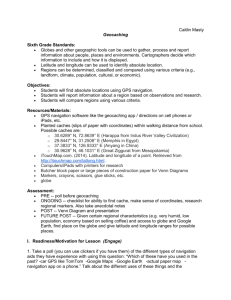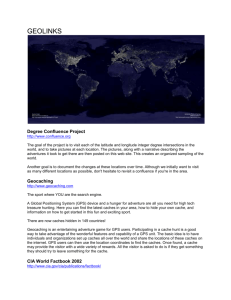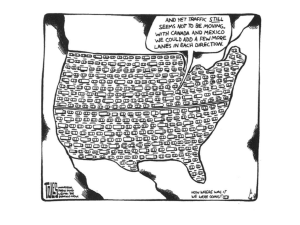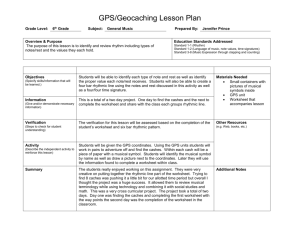2357-2012-1 - USDA Forest Service
advertisement
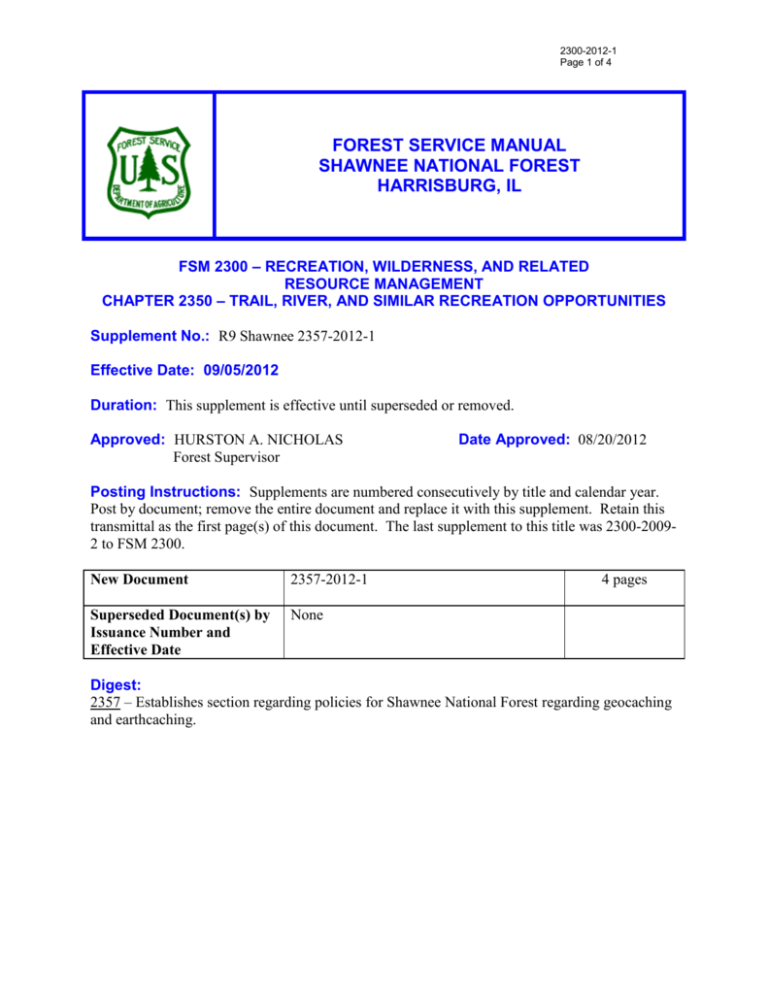
2300-2012-1 Page 1 of 4 FOREST SERVICE MANUAL SHAWNEE NATIONAL FOREST HARRISBURG, IL FSM 2300 – RECREATION, WILDERNESS, AND RELATED RESOURCE MANAGEMENT CHAPTER 2350 – TRAIL, RIVER, AND SIMILAR RECREATION OPPORTUNITIES Supplement No.: R9 Shawnee 2357-2012-1 Effective Date: 09/05/2012 Duration: This supplement is effective until superseded or removed. Approved: HURSTON A. NICHOLAS Forest Supervisor Date Approved: 08/20/2012 Posting Instructions: Supplements are numbered consecutively by title and calendar year. Post by document; remove the entire document and replace it with this supplement. Retain this transmittal as the first page(s) of this document. The last supplement to this title was 2300-20092 to FSM 2300. New Document 2357-2012-1 Superseded Document(s) by Issuance Number and Effective Date None 4 pages Digest: 2357 – Establishes section regarding policies for Shawnee National Forest regarding geocaching and earthcaching. R9 SHAWNEE SUPPLEMENT EFFECTIVE DATE: 09/05/2012 DURATION: This supplement is effective until superseded or removed. 2300, 50 Page 2 of 4 FSM 2300 – RECREATION, WILDERNESS, AND RELATED RESOURCE MANAGEMENT CHAPTER 2350 – TRAIL, RIVER, AND SIMILAR RECREATION OPPORTUNITIES Table of Contents 2357 – geocaching and earthcaching .......................................................................... 2 2357.01 - Objectives ................................................................................................................... 2 2357.02 – Policy ......................................................................................................................... 2 2357.03 - Definitions .............................................................................................................. 2 2357.1 - Administration of Geocaching ..................................................................................... 3 2357.11 - Policy .......................................................................................................................... 3 2357.1 - Administration of Earthcaching ................................................................................... 4 2357.21 - Policy .......................................................................................................................... 4 2357 – GEOCACHING AND EARTHCACHING 2357.01 - Objectives 1. Provide responsible geocaching and earthcaching activities on the Shawnee National Forest. 2. Prevent potential adverse impacts of geocaching and earthcaching activities recreational uses on natural, cultural, and historical resources. 2357.02 – Policy Regulate the use of geocaching and earthcaching on the Shawnee National Forest to the extent necessary to provide for user and public safety; to protect natural, cultural, and historical resources; to minimize conflict and maximize responsible use; to achieve recreation experience objectives; and to comply with Federal and State laws. 2357.03 - Definitions Geocaching. Geocaching is an adventure game for users of global positioning systems (GPS). Individuals and organizations set up caches all over the world and share the locations of these caches on the internet. GPS users can then use location coordinates to find the caches. Caches can be either “virtual,” meaning they exist only as coordinates that lead to a place, or “physical,” meaning that the coordinates lead to a thing to be found. Visitors to physical caches are asked to leave something in a container or to record their name on a paper log left at the site. More information regarding geocaching and the locations of geocaches already on the Forest, can be found at www.geocaching.com. Earthcaching. Earthcaching is similar to geocaching in that a GPS unit is used to guide a person to a site. Once there, however, no physical record is established or left behind. Earthcaching is sponsored on the World Wide Web by an organization called the Geological Society of America, which claims the National Park Service, among others, as partners in the endeavor. An earthcache site is a location where some unique geological feature reveals lessons about the R9 SHAWNEE SUPPLEMENT EFFECTIVE DATE: 09/05/2012 DURATION: This supplement is effective until superseded or removed. 2300, 50 Page 3 of 4 FSM 2300 – RECREATION, WILDERNESS, AND RELATED RESOURCE MANAGEMENT CHAPTER 2350 – TRAIL, RIVER, AND SIMILAR RECREATION OPPORTUNITIES formation of the earth or holds some other scientific or educational insight. Earthcache sites are established to provide environmental education about an area’s unique geological features without involving any disturbance at the site. Earthcaching, therefore, involves a “virtual” cache. As earthcaching leaves no physical record at the site, it is generally allowed on National Forest System lands insofar as the means of transport or access comply with established regulations in 36 CFR 261.9, or when not specifically prohibited by an order (36 CFR 261.53). Additional information about earthcaching can be found on the web at www.geosociety.org/ earthcache/guidelines.htm. 2357.1 - Administration of Geocaching 2357.11 - Policy 1. Geocaching involving the placement of small containers or objects is a permissible, dispersed recreational activity in many areas of the Forest. 2. Physical cache placement is not permitted in Bald Knob, Clear Springs, Panther Den, Bay Creek, Burden Falls, Lusk Creek, and Garden of the Gods Wildernesses, or in any natural area identified in the Forest Plan. Physical caches may not be placed at significant heritage resource sites—Millstone Bluff, Illinois Iron Furnace, Battery Rock, Great Salt Springs, Fountain Bluff and Hamburg Hill—or at any administrative sites (e.g. offices), radio tower sites or dams. Virtual Caches may be established in these areas. 3. No soil-disturbance is permitted during placement of any physical geocache. Caches should be covered with leaves or woody debris if the geocacher chooses to screen the cache at the site. 4. Geocachers must remove their cache if the location receives a large number of visits, as evidenced by a well-worn trail or path. 5. All caches must be relocated after one year regardless of site activity and either moved to a new location or removed from the Forest. 6. Caches and access routes must not be placed in dangerous, inappropriate, fragile, or protected areas or habitats, such as rock shelters, cliff ledges and overhangs, caves, bogs, wetlands, steep slopes, historic structures, and other sensitive sites. They must not be located in areas closed to the public. 7. Geocachers must follow all posted information at developed recreation sites. 8. Geocachers must not interfere with or detract from other visitors' experiences. 9. Caches must be for public use; no members-only or subscription caches are allowed. 10. Permits are required for commercial events. 11. Caches must not contain food, alcohol, tobacco, weapons of any type, fireworks, drugs, or other similar items. Caches must not be buried or hidden under water. 12. Forest personnel will remove geocaches that result in unauthorized impacts to forest resources, including, but not limited to: a. A cache-posting that encourages wheeled vehicle access in violation of posted rules, b. A cache-placement that causes ground disturbance or illegal or inappropriate use, especially in a restricted area, R9 SHAWNEE SUPPLEMENT EFFECTIVE DATE: 09/05/2012 DURATION: This supplement is effective until superseded or removed. 2300, 50 Page 4 of 4 FSM 2300 – RECREATION, WILDERNESS, AND RELATED RESOURCE MANAGEMENT CHAPTER 2350 – TRAIL, RIVER, AND SIMILAR RECREATION OPPORTUNITIES c. A cache-placement that causes the development of user trails or other resourceaffecting issues. 2357.1 - Administration of Earthcaching 2357.21 - Policy 1. Earthcaching is a permissible, dispersed recreational activity in most areas of the Forest. 2. Earthcachers must change or remove their cache location on the website if the site receives a large number of visits, as evidenced by a well-worn trail or path. 3. All cache locations must be changed or removed from the web after one year regardless of site activity. 4. Access-routes and caches must not be placed in dangerous, inappropriate, fragile, or protected areas or habitats, such as rock shelters, cliff ledges and overhangs, caves, bogs, wetlands, steep slopes, historic structures, and other sensitive sites. They must not be located in areas closed to the public. 5. Earthcachers must follow all posted information at developed recreation sites. 6. Earthcachers must not interfere with or detract from other visitors' experiences. 7. Caches must be for public use; no members-only or subscription caches are allowed. 8. Permits are required for commercial events.



